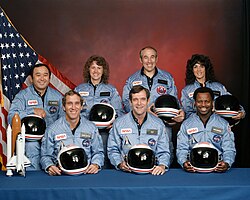 Challenger launches at the start of STS-51-L. 73 seconds later, the right SRB aft strut would fail, causing the aerodynamic breakup of the orbiter and the deaths of all 7 crew on board. | |
| Names | Space Transportation System-25 |
|---|---|
| Mission type | Satellite deployment |
| Operator | NASA |
| Mission duration | 6 days and 34 minutes (planned) 1 minute and 13 seconds (achieved) |
| Distance travelled | 18 mi (29 km) |
| Orbits completed | Failed to achieve orbit (96 planned) |
| Spacecraft properties | |
| Spacecraft | Space Shuttle Challenger |
| Launch mass | 2,685,210 lb (1,217,990 kg) |
| Landing mass | 199,704 lb (90,584 kg) (planned) |
| Payload mass | 48,363 lb (21,937 kg) |
| Crew | |
| Crew size | 7 |
| Members | |
| Start of mission | |
| Launch date | January 28, 1986, 16:38:00 UTC (11:38 am EST) |
| Launch site | Kennedy, LC-39B |
| Contractor | Rockwell International |
| End of mission | |
| Destroyed | January 28, 1986, 16:39:13 UTC (11:39:13 am EST) |
| Landing date | February 3, 1986, 17:12:00 UTC (12:12 pm EST) (planned) [1] |
| Landing site | Kennedy, SLF Runway 33 (planned) |
| Orbital parameters | |
| Reference system | Geocentric orbit (planned) |
| Regime | Low Earth orbit |
| Perigee altitude | 177 mi (285 km) |
| Apogee altitude | 183 mi (295 km) |
| Inclination | 28.45° |
| Period | 90.40 minutes |
| Instruments | |
| |
 STS-51-L mission patch  Back row: Onizuka, McAuliffe, Jarvis and Resnik Front row: Smith, Scobee and McNair | |
STS-51-L was the disastrous 25th mission of NASA's Space Shuttle program and the final flight of Space Shuttle Challenger.
Contents
- Planned mission
- Crew
- Backup crew
- Crew seat assignments
- Ascent failure and disaster
- Crew fate
- Mission objectives
- Mission insignia
- See also
- References
- External links
It was planned as the first Teacher in Space Project flight in addition to observing Halley's Comet for six days and performing a routine satellite deployment. The mission never achieved orbit; a structural failure during its ascent phase 73 seconds after launch from Kennedy Space Center Launch Complex 39B on January 28, 1986, destroyed the orbiter and killed all seven crew members—Commander Francis R. "Dick" Scobee, Pilot Michael J. Smith, Mission Specialists Ellison S. Onizuka, Judith A. Resnik and Ronald E. McNair, and Payload Specialists Gregory B. Jarvis and S. Christa McAuliffe.
Immediately after the failure, President Ronald Reagan convened the Rogers Commission to determine the cause of the explosion. The failure of an O-ring seal on the starboard Solid Rocket Booster (SRB) was determined to have caused the shuttle to break up in flight. Space Shuttle flights were suspended for 32 months while the O-rings and other hazards that could have destroyed the vehicle on following missions were addressed. Shuttle missions resumed in September 1988 with STS-26.




